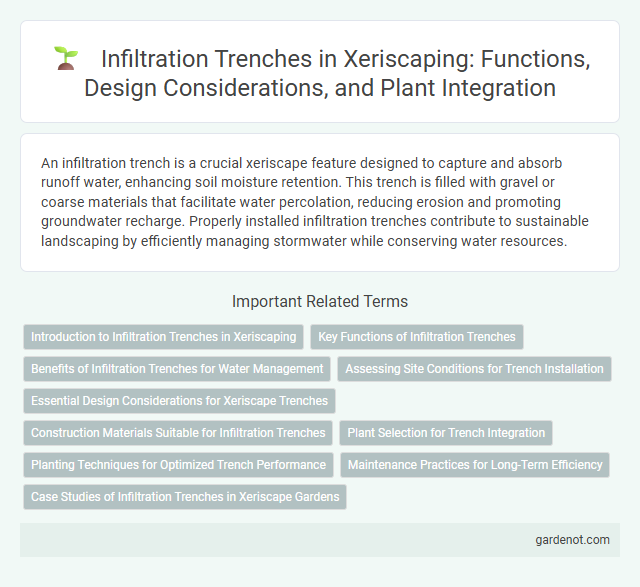An infiltration trench is a crucial xeriscape feature designed to capture and absorb runoff water, enhancing soil moisture retention. This trench is filled with gravel or coarse materials that facilitate water percolation, reducing erosion and promoting groundwater recharge. Properly installed infiltration trenches contribute to sustainable landscaping by efficiently managing stormwater while conserving water resources.
Introduction to Infiltration Trenches in Xeriscaping
Infiltration trenches are shallow, gravel-filled channels designed to capture and slowly infiltrate stormwater runoff, reducing erosion and promoting groundwater recharge in xeriscape landscapes. These trenches effectively manage water on-site by facilitating the absorption of rainwater into the soil, minimizing water waste in drought-prone areas. Incorporating infiltration trenches in xeriscaping enhances water conservation, supports native vegetation, and helps maintain soil moisture balance.
Key Functions of Infiltration Trenches
Infiltration trenches play a crucial role in xeriscaping by managing stormwater runoff through deep soil absorption, reducing surface water accumulation. These trenches facilitate groundwater recharge by allowing water to percolate slowly, minimizing erosion and mitigating flood risks in arid landscapes. Their design promotes sustainable water use, supporting plant health and conserving municipal water resources.
Benefits of Infiltration Trenches for Water Management
Infiltration trenches enhance water management by capturing and directing stormwater runoff into the soil, reducing surface flooding and promoting natural groundwater recharge. These structures filter pollutants from runoff, improving water quality while minimizing erosion and sedimentation in nearby waterways. Incorporating infiltration trenches in xeriscape landscapes supports sustainable water conservation by efficiently managing rainwater on-site.
Assessing Site Conditions for Trench Installation
Assessing site conditions for infiltration trench installation requires evaluating soil permeability, slope gradient, and groundwater levels to ensure effective water absorption and prevent surface runoff. Conducting percolation tests determines the infiltration rate, while identifying potential obstructions like rock layers or high water tables guides appropriate trench depth and placement. Proper assessment maximizes stormwater management efficiency and supports xeriscape sustainability.
Essential Design Considerations for Xeriscape Trenches
Infiltration trenches in xeriscape design require careful soil permeability assessment to ensure proper water absorption and prevent runoff. Selecting appropriate trench dimensions, typically 1 to 3 feet wide and 2 to 4 feet deep, optimizes water infiltration while minimizing erosion. Incorporating native, drought-tolerant plants and permeable materials enhances trench functionality and promotes sustainable landscape irrigation.
Construction Materials Suitable for Infiltration Trenches
Infiltration trenches are constructed using highly permeable materials such as washed gravel, coarse sand, and crushed stone to facilitate efficient stormwater absorption and prevent surface runoff. Incorporating geotextile fabric liners enhances soil stability while preventing fine sediment clogging, ensuring long-term trench functionality in xeriscape landscapes. Selecting materials with optimal porosity and durability promotes effective groundwater recharge and sustainable water management in arid environments.
Plant Selection for Trench Integration
Selecting drought-tolerant native grasses and deep-rooted perennials enhances water absorption efficiency in infiltration trenches. Incorporating species such as bunch grasses, sedges, and wildflowers promotes soil stabilization and reduces erosion within the trench system. Proper plant selection improves infiltration rates and supports sustainable xeriscape design by maximizing water retention and minimizing runoff.
Planting Techniques for Optimized Trench Performance
Infiltration trenches require precise planting techniques to enhance water absorption and soil stabilization. Selecting deep-rooted, drought-tolerant native plants improves soil permeability and reduces erosion within the trench system. Incorporating a mix of grasses and shrubs with complementary root structures maximizes infiltration efficiency and supports long-term xeriscape sustainability.
Maintenance Practices for Long-Term Efficiency
Infiltration trenches require regular removal of accumulated sediments and periodic inspection to prevent clogging and maintain groundwater recharge efficiency. Routine maintenance includes clearing debris, inspecting underdrains, and ensuring surrounding vegetation does not obstruct infiltration surfaces. Proper upkeep extends the trench's lifespan, enhances water quality, and sustains effective stormwater management in xeriscape landscapes.
Case Studies of Infiltration Trenches in Xeriscape Gardens
Case studies of infiltration trenches in xeriscape gardens highlight their efficiency in managing stormwater by promoting groundwater recharge and reducing runoff. Research from arid regions demonstrates that properly designed trenches using native gravel and soil amendments can retain up to 85% of rainfall, supporting drought-resistant plant growth. These case studies emphasize that infiltration trenches contribute to sustainable landscaping by enhancing soil moisture without requiring supplemental irrigation.
Infiltration trench Infographic

 gardenot.com
gardenot.com